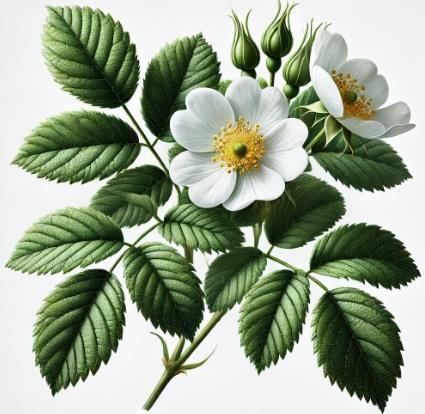Lucia rose (Rosa luciae), commonly known as the Lucia rose, is a species of wild rose native to certain regions in the northern hemisphere. It is recognized for its striking appearance, with large, colorful flowers and its ability to thrive in various environments. Rosa luciae is valued for its ornamental qualities and adaptability to different growing conditions.
Botanical Classification:
Kingdom: Plantae
Order: Rosales
Family: Rosaceae
Genus: Rosa
Species: Rosa luciae
Plant Characteristics:
Rosa luciae is characterized by:
Flowers: Large, vibrant blooms that can be pink, red, or white, often with a subtle fragrance. The flowers are typically borne singly or in small clusters.
Foliage: Dark green, glossy leaves with a pinnate structure and serrated edges. The foliage is dense and complements the plant’s floral display.
Growth Habit: A deciduous shrub that usually reaches heights of 1.5 to 2 meters. It has a bushy, spreading growth habit, with strong, thorny stems.
Soil and Light: Prefers well-drained soil and full sunlight. It is adaptable to a variety of soil types and is capable of tolerating a range of environmental conditions, including some degree of drought.
Chemical Composition and Structure:
The chemical composition of Rosa luciae includes:
Essential Oils: Contains aromatic compounds such as geraniol and citronellol, contributing to its mild fragrance.
Flavonoids and Tannins: Found in the leaves and flowers, providing antioxidant and astringent properties.
Organic Acids: Present in the foliage and flowers, contributing to the plant’s overall aromatic profile and potential health benefits.
Uses and Benefits:
Aesthetic: Highly valued for its vibrant and large flowers, making it a popular choice for ornamental gardening, floral arrangements, and landscape design.
Cosmetic: Extracts from the flowers can be used in perfumes and skincare products for their subtle fragrance and potential skin-soothing properties.
Medicinal: Traditionally used in herbal medicine for its potential soothing effects and mild astringency. Scientific evidence supporting these uses is limited.
Culinary: While not commonly used in culinary applications, rose hips from Rosa luciae can be utilized to make herbal teas and infusions, providing a mild flavor and a source of vitamin C.
Applications:
Gardening: Ideal for ornamental purposes in garden beds, borders, and as a specimen plant due to its attractive flowers and bushy growth habit.
Cosmetics: Flower extracts used in perfumes and skincare products for their fragrance and soothing qualities.
Medicinal: Employed in traditional herbal remedies for its astringent and soothing properties, though scientific evidence is limited.
Culinary: Rose hips may be used in teas and infusions for their flavor and vitamin C content.
Environmental and Safety Considerations:
Environmental Impact: Adaptable to various garden environments; contributes to garden aesthetics and local biodiversity.
Safety: Generally safe to handle and use; individuals with allergies or sensitivities should exercise caution. Consulting a healthcare provider is recommended before using Rosa luciae for medicinal purposes.
INCI:
Skin conditioning agent. It is the mainstay of topical skin treatment as it has the function of restoring, increasing or improving skin tolerance to external factors, including melanocyte tolerance. The most important function of the conditioning agent is to prevent skin dehydration, but the subject is rather complex and involves emollients and humectants that can be added in the formulation.
Synonyms:
CAS:
![]() Lucia Rose
Lucia Rose 

